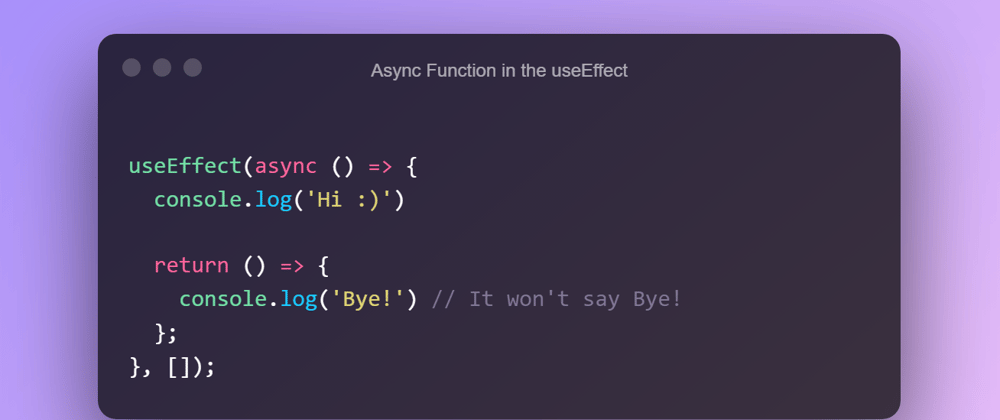When you're new to React Hooks, you may notice that you get warnings and bugs if you use an async function inside the useEffect Hook. Let's find out why this happens.
There are dozens of articles and issues about how to use async in the React Hooks:
Why is this happening?
Async functions always return a promise so you will not have the actual value until the Promise is fulfilled.
Anti-Pattern: async function directly in the useEffect
React can run this async function but can not run the cleanup function.
Don't use raw async function directly in the useEffect.
useEffect(async () => {
console.log('Hi :)')
return () => {
console.info('Bye!') // It won't run
};
}, []);
Code example: using unmount in async functions.
You don't have to unmount callback unless you use await expression before it.
unmount = await (async () => {
console.log('Hi :)')
return () => {
console.info('Bye!')
};
})()
unmount()
// Hi :)
// Bye!
Code example: using unmount in a function.
unmount = (() => {
console.log('Hi :)')
return () => {
console.info('Bye!') // 👍
};
})()
unmount()
// Hi :)
// Bye!
Code example: using async function in the useEffect.
You can create an async function in the useEffect callback, as Nick mentioned in his article.
useEffect(() => {
(async () => {
const products = await api.index()
setFilteredProducts(products)
setProducts(products)
})()
return () => {
unsubscribeOrRemoveEventHandler() // 👍
}
}, [])
I hope you find this article useful.







Top comments (16)
As it was already mentioned in the comments, having raw async functions in the
useEffectis always a bad idea. Once created, the promise cannot be stopped, it will inevitably resolve or fail, even if the component itself is long gone.In other words, one needs to make sure that when promise results are evaluated the mounted state is taken into consideration or that errors are properly silenced
Exactly... and then the console yells at you that there's a state changed in a unmounted component and that's a memory leak bug in the app.
After sometime experimenting with api call in useEffect at work we got to the conclusion that any async logic state goes to Redux. Better to have a more complex and organized store and leave components with simple logic.
As Samuel mentioned, we can check if the component is unmounted or not to update the state.
Not really... You shouldn't really be doing handcrafted isMounted checks at all. To prevent state updates from an unstoppable promise/async function, use a ref on an HTML element on whatever you are rendering on this component, if the ref.current value is null then throw in the promise or exit the async function gracefully, skipping any updates.
Of course for fetch/axios there's a proper abort/cancel mechanism.
Unless you're using async effects with cancelable promises :)
Hey in order to get data once and prevent useEffect hook that render the data in the infinite loop you should just initialize an empty array as a second argument to the useEffect hook like this
useEffect(() => {
// use code here
}, [])
A simplistic way to dump the result would be to track whether the useEffect's unsubscribe function has been called using:
But as others have said, Redux is often the way to go if you are doing this often and there are also the
use-async-effectand@react-hook/asyncpackages foruseAsyncEffectimplementations.I'm still getting the error
ESLint: Promises must be handled appropriately or explicitly marked as ignored with the `void` operator.(@typescript-eslint/no-floating-promises)on the async word on the second line
Can you share your code?
I think there is an error in the following sentence:
Async functions always return a promise so you will have the actual value until the Promise is fulfilled
It should be
Async functions always return a promise so you will NOT have the actual value until the Promise is fulfilled
Thank you, I made a grammatical error
You mention two npm packages, but pulling in two extra npm packages just to get data from an api (something every page will require on average) is not a good "solution". And if those are the react external docs for using an api within useEffect, a lot of people are going to be googling elsewhere for solutions, as it's not even mentioned within the first ten pages of text. And explicitly says that APIs are one of the use cases of useEffect, then doesn't exaplain how to interact with an api in the guide itself.
At it's base, let's say you have
fetch&Reactavailable, not two custom developed packages from the npm ecosystem. You then need to load in api data from the results of a promise, and using async/await should be the first step... ...which causes problems with useEffect.Catch-22. What a mess.
Hey, I didn't understand the concept thoroughly. Can you explain a little bit more.
Some developers tried to use async functions in useEffect and got warnings/bugs with the following code:
Anti-Pattern: async function directly in the Hook
I have explained the reason why eslint shows warnings and our cleanup function will not run (because of the async function).
Async functions have to be written in the callback as follows:
There is an useAsyncEffect custom hook. (Out there in some npm package) The cleanup function is passed in a separate parameter, so it doesn't share the full scope of the effect function, like it does in the original useEffect hook.
You may write your own if that option is more pleasant.
??? What is then the alternative? I mean, we're reaching out to an api over the network, as is necessary.